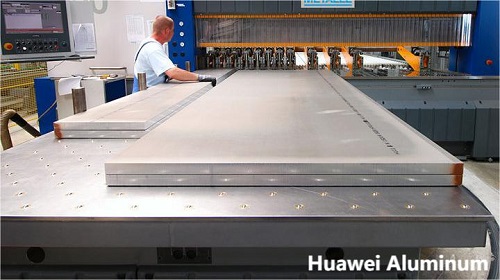Qu'est-ce que la tôle d'aluminium laminée?
La tôle d'aluminium laminée fait référence à une tôle d'aluminium fabriquée par un procédé de laminage. Le processus de laminage consiste à faire passer un lingot ou une billette de métal à travers une série de rouleaux pour réduire son épaisseur et le façonner en une feuille d'épaisseur uniforme.. Le procédé est utilisé pour produire des feuilles d'aluminium de dimensions spécifiques, propriétés d'épaisseur et de surface adaptées à diverses applications.
 rolled aluminum sheet product
rolled aluminum sheet productProcess of rolling aluminum sheet
The process of producing rolled aluminum sheet involves several steps, starting from aluminum raw material, to the final rolled sheet with the desired thickness and dimensions. The two main methods of producing rolled aluminum sheet are hot rolling and cold rolling. Here’s an overview of the process:
1. Ingot casting preparation:
The process starts with the preparation of aluminum ingots. These ingots are usually cast from molten aluminum in a mold and allowed to solidify. The composition and alloy of the ingot is carefully controlled according to the intended application of the rolled plate.
2. Homogenization (optional):
Dans certains cas, especially for certain aluminum alloys, the ingot may undergo a homogenization process. This helps ensure uniformity in the material’s microstructure and composition.
3. Heating (hot rolling only):
During hot rolling, steel ingots are preheated to high temperatures to make them more ductile and easier to deform.
4. Laminage à chaud:
During hot rolling, a preheated aluminum ingot passes through a series of rolling mills, gradually reducing its thickness while extending its length. The process involves multiple passes over the rollers with gradually decreasing gaps between them.
The hot rolling process reduces the thickness of aluminum while increasing its length and width. Materials are subjected to compressive and tensile forces during rolling.
5. Recuit (cold rolling only):
Cold rolling involves passing aluminum through rolls at or near room temperature. To prevent the material from becoming too brittle and increase its ductility, an intermediate annealing step can be introduced during cold rolling.
6. Cold rolling:
The process of cold rolling is similar to hot rolling, but at a lower temperature. Through multiple passes between the rollers with gradually decreasing gaps, the material is gradually thinned and elongated.
7. Surface treatment and coating (optional):
Après avoir roulé, aluminum sheet may be surface treated or coated to improve its surface finish, résistance à la corrosion, or other properties.
8. Cutting and shearing:
The rolled aluminum sheet is cut and sheared to the required size. This step ensures that the sheet is uniform in size and meets specified tolerances.
9. Quality control:
Rolled aluminum sheets undergo rigorous quality control inspections to ensure compliance with industry and customer specifications. These inspections include measurements of thickness, dimensions, mechanical properties and surface quality.
10. Packaging and delivery:
The final rolled aluminum sheet is packaged and ready for distribution to manufacturers and industries who use it for various applications such as construction, transport, emballage, etc.
What are rolled aluminum sheet used for?
Rolled aluminum sheets are used in a wide variety of industries and applications due to their versatility, poids léger, résistance à la corrosion, and ease of fabrication. Some common uses for rolled aluminum sheet include:
Aluminum panels are used to build:
Roof and Siding: For its durability, résistance à la corrosion, and aesthetics, rolled aluminum sheet is used for roofing, bardage, and other architectural elements.
Wall cladding: Aluminum panels are used for exterior and interior wall cladding in commercial and residential buildings.
Curtain Wall: Rolled aluminum panels are a key component of the curtain wall system, providing structural support and aesthetic elements.
Aluminum sheet for transport:
Automobile: Due to its lightweight nature, rolled aluminum sheet is used to make body panels, cagoules, doors and other parts that help improve fuel efficiency.
Aérospatial: In the aerospace industry, aluminum sheet is used for aircraft structures, ailes, fuselage and interior components.
Navires: Due to their corrosion resistance in marine environments, aluminum sheets are used for hulls, decks and superstructures.
Aluminum plate for packaging:
Aluminum cans: Rolled aluminum sheets are used to make beverage cans because of their light weight, barrier properties to protect the contents, et recyclabilité.
Foil packaging: Thin sheets of aluminum are used to make flexible packaging materials, such as the foil used to package food, médicaments, et d'autres produits.
La feuille d'aluminium est utilisée dans la fabrication:
appareils électroménagers: Les tôles d'aluminium laminées sont utilisées dans la production d'appareils électroménagers tels que les réfrigérateurs, fours, et machines à laver.
Machines et équipements: La feuille d'aluminium est utilisée pour fabriquer des composants pour diverses machines et équipements industriels.
Tôle d'aluminium pour l'électricité et l'électronique:
Conducteur: Aluminum sheets are used as electrical conductors for power transmission and distribution due to their good electrical conductivity and lightweight properties.
Electronic Components: Aluminum sheet is used to make electronic housings, housings and heat sinks.
Aluminum panels for signage and displays:
Outdoor Signage: Due to its weather resistance and customizable properties, rolled aluminum sheet is commonly used for outdoor signage and displays.
Aluminum sheet for cookware and kitchen accessories:
Pots and Pans: Aluminum sheet is used in the production of cookware due to its excellent thermal conductivity and light weight properties.
Baking pans: Baking pans and trays are usually made of aluminum because it distributes heat evenly.
The versatility of rolled aluminum sheet, combined with its corrosion resistance, formabilité, et propriétés légères, make it the first choice for a wide range of applications across industries.
